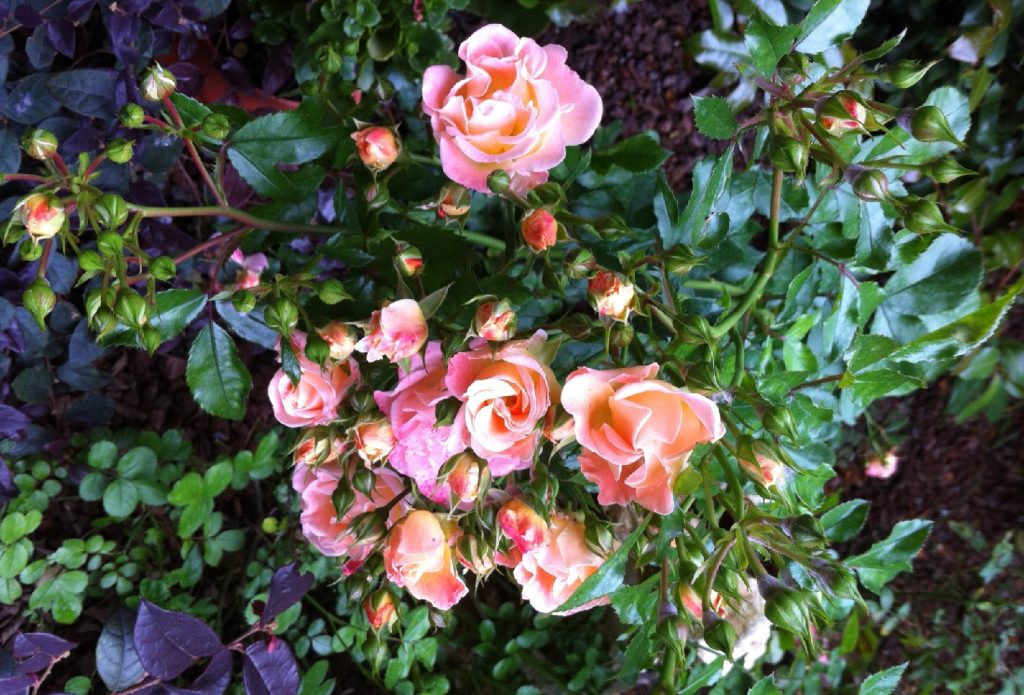
Plant your roses in good moisture-retentive compost, and place them where they will receive at least six hours of direct sunlight each day. Use a granular fertilizer made specifically for roses to supply the ideal ratio of nutrients and promote blossom. Roses should be continuously pruned and deadheaded throughout the summer to encourage additional blooms.
Read on to learn how to precisely encourage more blossoms that remain longer so that your rose can bloom throughout spring, summer, and fall.
Table of Contents
Use the Right Fertilizer to Increase Rose Blooms
Since roses tend to be heavy eaters, fertilizer is essential to getting the finest bloom show. Using excessive amounts of fertilizer is among the major risks to rose blossoms. The high quantities of nitrogen induce plenty of green, luxuriant foliage growth rather than blossoms if you apply too much.
It is crucial to use the proper balance of fertilizer to encourage roses to bloom more because excessive new growth makes plants more vulnerable to pests, illnesses, and frost damage, as well as producing less flowers.
The nutrients are released into the soil more gradually throughout the course of the season when using granular fertilizer as opposed to liquid fertilizer, which distributes the nutrients all at once.
This lowers the chance of using too much fertilizer, which could prevent your rose from blooming, and allows the roots to absorb the necessary nutrients to encourage bloom development.
(Read my article to learn why my rose isn’t in bloom. to access a troubleshooting manual).
I hear you asking, “What fertilizer should I use for my rose?” If unsure, use rose-specific fertilizer, as depicted in the image. This makes it easier for you to be more precise and less stressful to choose the right fertilizer.
I’ve personally tested a few of the available rose fertilizers, and miracle-gro granular fertilizer consistently produces the best results, with a strong display of blossoms (and a robust, healthy rose).
Because their roots can deplete the soil of nutrients if they are kept in the same pot for a long period, roses in pots require careful fertilizer application (see my post on selecting the best containers for roses).
Prepare the Soil and Add Mulch to get More Rose Blooms
For a rose to be healthy and produce a lot of blossoms, the soil must be properly prepared.
Prior to planting roses, it is recommended to amend the soil with a lot of organic matter, such as compost, leaf mold, or well-rotted manure. These materials provide the best soil characteristics for roses, as they are able to retain moisture while the porous, friable structure allows excess water to drain away to prevent boggy soil, which results in root rot.
Before planting, it is especially important to amend the soil if it contains heavy clay or sandy soil. Heavy clay can prevent roots from establishing and can bake hard in the summer, which prevents water from penetrating the soil and reaching the roots. Sandier soil also dries out too quickly and does not retain nutrients.
If the poor soil conditions are causing your rose to perform poorly, you might want to think about transplanting it (preferably in the early spring or fall).
To allow for the roots’ full size as they mature, amend the soil to a depth of 18 inches. A good concentration of nutrients is also included in compost, leaf mold, and well-rotted manure, which helps your rose produce more blossoms.
Apply a 2 inch layer of mulch to the soil surface around your rose bush in the spring to encourage more rose blossoms, but leave a 3-inch space around the rose wood (avoid contact with the actual rose wood as any wood above ground does not like to be in contact with consistently moist material).
Start doing this in the early spring to preserve moisture for the dry summer. Additionally, it will offer nutrients that will help your rose produce more flowers in the summer and keep the roots cool.
Mulch also nourishes the ecology of the soil, which converts organic matter into chelated form, making it simpler for rose roots to absorb and fostering the ideal circumstances for increased flowering.
If you want extra points, mulch your rose once more before the winter because this protects the roots from the cold and promotes their establishment, giving the rose a head start in the spring.
Locate Roses in Full sun for More Flowers
The rose produces more blossoms the more sunlight it receives each day.
The sun encourages the growth of flower buds and gives the rose the energy it needs to produce additional blooms.
Roses need have at least six hours of sunshine each day, which is why they bloom more in hot summer months. Because spring is a crucial time for the formation of rose buds, there can be significant annual variation in how much your rose shrub blooms. In some years, the spring weather is more cloudy, which leads to less flowers.
The best thing to do if your rose is not in a sunny spot is to move it to a spot where it can receive at least six hours of direct sunlight each day. Roses should be moved in the early spring or fall to give the roots time to establish themselves without being subjected to summer heat.
Alternately, trim any huge shrubs or overhanging tree limbs that may be shading your rose too much.
To avoid depriving one another of sunlight when planting numerous roses, space them three feet apart. This will improve airflow and lower the chance of fungus and reduce the risk of illness. Additionally, the room will protect you from the thorns as you wander around your roses during pruning!
Roses Flower on New Growth (Prune in Late Winter to get More Flowers)
The importance of annual trimming is due to the fact that the lanky old growth does not flower as quickly.
To improve air circulation and encourage new growth, prune any individual dying branches back to healthy growth (or the crown).
A word of warning, though: Heirloom climbing roses and shrub roses flower on old growth, which means they should be clipped as soon as they bloom, in contrast to the great majority of ornamental modern bush roses that are offered in garden centers. If you are unsure, do some research on your particular variety of climbing rose.
Regular Deadheading Spent Blooms Increases Flowers
Deadheading the spent blooms on a regular basis encourages the growth of fresh blossoms!
Without deadheading, the energy of the rose is directed toward the production of rose hips, or rose seeds, at which point the rose can stop blossoming because the task of creating seeds has been completed.
Regular deadheading diverts the rose’s energy from generating rose hips towards increased flower display, resulting in longer and more prolific blooming.
With a pair of pruners, remove the wasted rose blossoms as soon as they appear. This enhances the rose’s beauty and prolongs the season of blooming.
Regular deadheading can extend the blooming season of roses into the fall.
Treat Pests Quickly to Increase Flowering
Regularly check your rose for insects like aphids. In the spring or summer, aphids prefer to feed on the sap of rose plants that are just emerging, especially the budding roses.
As fertilizer causes roses to get sappy and droop, they tend to be more common on roses that have been excessively fertilized, therefore be sure to use a granular fertilizer made specifically for roses!
Your roses’ ability to blossom may be harmed by aphids, therefore getting rid of them is crucial. Aphids can be eliminated in a number of methods, but hand removal is the most effective and efficient.
This halts them in their tracks and triggers the release of a stress alarm chemical by the aphid colony, which inadvertently draws in ladybirds and other aphids’ natural predators.
If the infection is cured, the rose will bounce back and may even blossom the following season.
– Deadhead your flowers for more (and longer) blooms.The sun energizes the rose and helps it generate flower buds so that it can produce more blooms.
Moist Soil Stimulates More Flowers

The best thing to do if your rose isn’t in a sunny spot is to move it to one where it can get at least six hours of sun per day. Early spring or late fall are the best times to move roses since the roots will have more time to establish themselves and won’t have to deal with the summer heat.
Alternately, prune any overhanging bushes or tree limbs that may be shading your rose too much.
- Plant many roses three feet apart so that they don’t shade one another out; this will improve airflow and lower the chance of fungus disease. As you prune your roses, the area will also prevent you from getting harmed by the thorns as you move around.
- The growth of new stems and branches, which support the flowers, is sped up by pruning in late winter (February/March). Regular pruning keeps a rose from growing long and unproductive by preventing it from becoming lanky.
- Annual pruning is crucial since the old, lanky growth does not blossom as quickly.
To improve air circulation and encourage new growth, prune any individual branches that are withering back to healthy growth (or the crown).
A word of warning, though: Heirloom climbing roses and shrub roses flower on old growth, so they should be clipped right away after blooming, in contrast to the great majority of ornamental modern bush roses that are marketed in garden centers and bloom on new season growth. If in doubt, do some research on the particular climbing rose variety you have.
In order to get a clear visual reference on how to trim roses correctly to produce more flowers, I highly suggest viewing this YouTube video:
The growth of fresh flowers is encouraged by routinely deadheading the spent blossoms!
Without deadheading, the energy of the rose is directed toward the production of rose hips, or rose seeds, at which point it is no longer necessary for the rose to continue producing blooms because the task of creating seeds has been completed.
Key Takeaways:
- Regular deadheading diverts the energy that the rose would have used to produce rose hips into the display of more flowers, resulting in longer and more prolific blooming for your rose.
- With a pair of pruners, cut the spent-looking rose blooms off as soon as they appear. Consequently, the rose looks better and continues to bloom throughout the entire season.
- Roses can bloom well into the fall with regular deadheading.
- Pests like aphids should be frequently checked for on your rose. In the spring or summer, aphids prefer to feed on the sap of newly sprung roses, especially the forming rose buds.
- Since fertilizer makes roses sappy and droopy, they are more common on roses that have been overfertilized, so be sure to use a granular fertilizer made just for roses!
